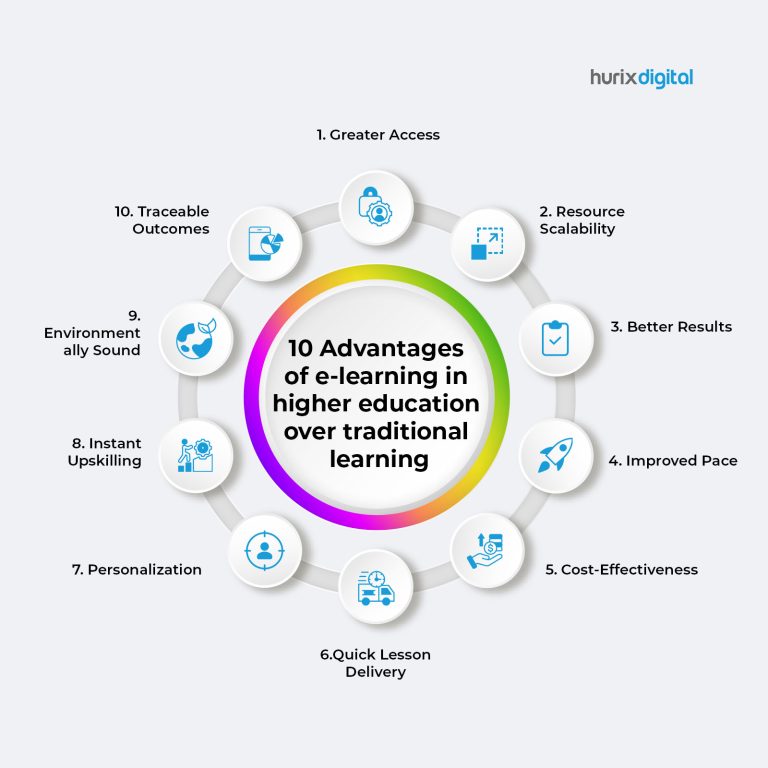10 Advantages of e-Learning in Higher Education over Traditional Methods
In this digital era, the education sector is undergoing a massive transformation. Students and universities worldwide are no longer relying on the age-old, uni-dimensional, chalk-and-board methods of learning. Instead, they have witnessed the advantage of e-learning and have started to embrace a variety of online tools to facilitate, simplify and contextualize the entire learning process like bringing in e-learning in higher education. Here’s a list of Top Online Learning Development and Delivery Tools.
As a result, the global e-learning market has begun to witness a meteoric rise. So much so, the revenue from e-learning is expected to touch the magic figure of almost $325 billion by 2025! Here are 9 Reasons for the Growth of eLearning in Education.
In such a time, where learners are required to grapple with an immense wealth of information daily, it becomes imperative to understand the importance of e-learning in higher education over the tried and tested, more conventional methodologies.
Here is a list of the 10 e-learning advantages in higher education over its traditional counterparts:

- Greater Access
- Resource Scalability
- Better Results
- Improved Pace
- Cost-Effectiveness
- Quick Lesson Delivery
- Personalization
- Instant Upskilling
- Environmentally Sound
- Traceable Outcomes
1. Greater Access: Benefits for Students Beyond Boundaries
One of the biggest advantages of online learning in higher education is that it transcends geographical boundaries. It allows students the benefit of a class, irrespective of their physical location.
For example, students can easily attend courses from prestigious universities like Oxford & Harvard via e-learning. The need to be close to either the university or the teacher is completely eliminated.
2. Resource Scalability: Save Time & Money
E-learning enables institutions to save a great amount of time & money. They don’t have to incur any form of expenditure in terms of hiring instructors, purchasing equipment or other resources. Instead, they can use these saved up resources to improve the quality of the overall learning process. Here are top 10 Reasons Why Institutions Should invest in Online Learning Programs.
Moreover, unlike traditional classrooms, e-learning does not restrict an educator’s reach. As a result, students get to learn on an individual basis, at their convenience.
3. Better Results: Benefits of E-learning in Information Retention
E-learning in higher education has been known to improve productivity, augment focus and thereby, provide better academic results. In fact, as per research, students can boost their retention rates by as much as 25-60% through e-learning.
This is because audio-visual learning coupled with a host of variable media formats, tends to cast a positive influence on the learner’s ability to grasp and retain information. This further improves scores & refines results. Here’s more on the Importance of Digital Curriculum Development in Higher Education.
4. Improved Pace: Quick & Effective Learning Anytime
The process of e-learning is, by and large, self-paced. This is to say that e-learning enables students to learn subjects, at a time and pace of their convenience. They don’t have to worry about missing out on other opportunities merely to strengthen their academic credentials.
Similarly, students can choose their own pace of understanding, without having to experience the constant peer pressure to learn quickly and perform well.
WHITEPAPER:
Revolutionizing the employee learning experience with VR and AR
5. Cost-Effectiveness: Save Money on E- Learning vs Traditional Learning
Quite like institutions, e-learning can prove to be a cost effective alternative for students too. Traditional methods of education are more expensive because they include the charges of trainers, classrooms, course materials, travel and accommodation.
However, e-learning gets rid of all these costs, helping students enroll for a course of their choice. In the longer run, these economical rates empower students to give their professional careers a tremendous boost. Here are the Best Practices for Effective Online Course Development.
6. Quick Lesson Delivery: Dynamic and Quick Learning Process
As compared to traditional methods of lesson delivery, e-learning is much more sophisticated, dynamic and quick. Most e-learning lessons are wrapped up within a single academic session.
Nonetheless, students are given the flexibility to extend or reduce their session time, depending on their needs and requirements. Learners can choose to skip the areas that they are already familiar with while focusing their energies on more relevant subjects. Here’s all you need to know about The Making of Future-proof Online Learning Programs and Courses.
7. Personalization: Customized Course Structure
E-learning in higher education does not usually take place in a group setting. Instead, it imparts education in a more personalized, distinct, specific and transparent way. Students can choose to ask questions, leave feedback, get responses, seek repetitions and clarify doubts as per their own level of comprehension.
This learning technique addresses issues, resolves problems and customizes the entire course structure to suit the student’s demands. Here are 10 eLearning Design Techniques for Improved Learner Engagement
8. Instant Upskilling: Helps to Expand Your Capabilities
In a time where skills are required to be updated regularly, e-learning can prove to be an immensely helpful tool. Be it students, veterans, beginners, experts or mid-career professionals – e-learning enables everyone to upskill themselves at a time and place of their choice.
Neither do they have to enroll in a formal school, nor are they required to explore any other opportunities. With e-learning, they can learn quickly & thereby, perform better.
9. Environmentally Sound: Hassle-Free Learning Opportunities
As per a study by UK’s Open University, e-learning has enormous capability to reduce an institution’s carbon footprint. Using e-learning methods instead of traditional teaching practices can reduce total energy consumption by approximately 90% while lowering carbon dioxide emissions by over 85%! Being paperless, e-learning in higher education is an eco-friendlier studying option than other power consuming & resource exhausting alternates.
10. Traceable Outcomes: Easy to Track Learning Progress
Last but not least, e-learning works wonders when it comes to measuring outcomes, tracing results, and gathering feedback. While it is not possible to keep a close tab on every student seeking education under the traditional system, e-learning methods ensure that a continuous and consistent evaluation can be undertaken to assess regular progress. As a result, the needs of every student are accommodated & the quality of learning becomes better.The swift expansion of the internet to the remotest of areas, will further improve access, enhance options and thus, empower both students and institutions to get maximum e-learning advantages. E-learning in higher education will not just function as a medium of initiating inclusion, but it will also operate as the sole harbinger of excellence, proficiency, and opportunity.
Related:
Online Learning Programs: Why Every Institution is Going Digital
Digital Solutions for Universities and Higher Education Institutions
Why Should You Outsource Your Content Development
Why Should Colleges and Universities Develop eLearning Programs?
10 Tips to Select the Best Online Course Development Partner
Frequently Asked Questions (FAQs)
1. What are the advantages of e-learning in higher education compared to traditional methods?
A. E-learning offers several advantages over traditional education, including greater accessibility regardless of location, resource scalability, improved academic results, self-paced learning, and cost-effectiveness.
2. How does e-learning benefit students in terms of access to education?
A. E-learning eliminates geographical boundaries, allowing students to attend classes from prestigious universities like Oxford & Harvard regardless of their physical location.
3. How does e-learning contribute to better academic results?
A. E-learning improves information retention and academic outcomes through audio-visual learning and varied media formats, leading to a potential retention rate increase of 25-60%.
4. In what way does e-learning provide a more flexible learning pace?
A. E-learning allows students to learn at their own pace, without the pressure to conform to a standardized pace, enabling them to balance learning with other commitments.
5. How does e-learning compare to traditional learning in terms of cost-effectiveness?
A. E-learning proves to be a cost-effective alternative for both institutions and students, as it eliminates expenses related to trainers, classrooms, course materials, travel, and accommodation.
Need to know more about our Products & Services? Drop us a Note.

Senior Vice President – APAC
A Business Development professional with >20 years of experience with strong capability to sell new solutions and develop new markets from scratch. New Market Entry Specialist with experience of working in two of the largest emerging markets – China & India. Also covered other key markets in APAC & ME. Exceptional experience of conceptualizing, ideating and selling new learning technologies like VR AR, etc. across multiple industry verticals.









